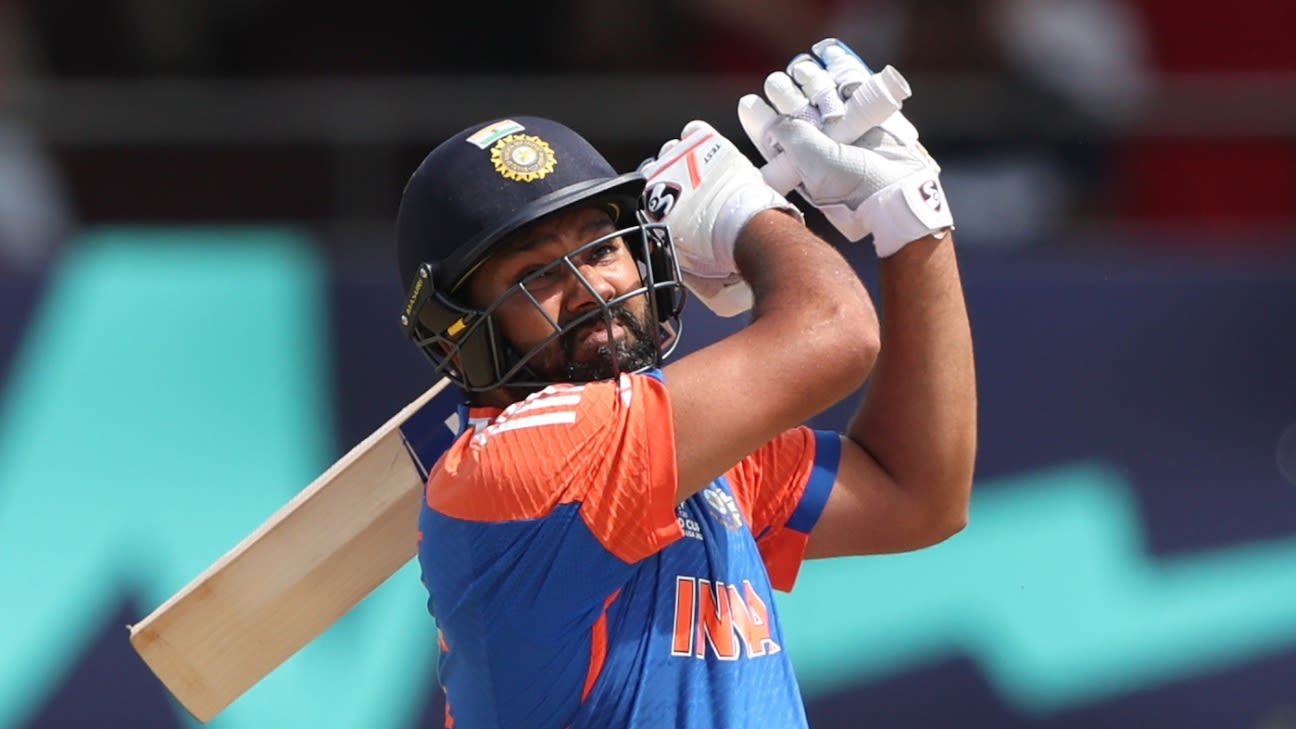World
Rohit Sharma, and India, earn their rewards for being brave

How do you measure success in T20s? How do you measure batting success in a T20 World Cup played on predominantly challenging pitches?
The truth, if there’s such a thing, is a lot more complicated, in a fickle format made fickler by the conditions in play in this tournament. It’s a lot more complicated because batting in T20, much more than in the other formats, is a team thing.
The truth, or something approaching that, is that both Rohit and Kohli have tried to bat in a way that has challenged them, a way that doesn’t necessarily come naturally to either of them, knowing that to bat this way is to walk a thin line between high-impact innings and early dismissal. They’ve both embraced this way of batting because if a line-up with depth, quality, and diverse skillsets bats this way, enough individuals will likely come good on most days and contribute to totals that give their team a strong chance of winning games.
In a tournament like this World Cup, where a batter can play a maximum of ten innings, to embrace this way of batting is to embrace the chance that you could end up with ordinary-looking numbers.
***
It has fallen to Kohli to get to the last lap of this World Cup with ordinary-looking numbers, but it’s unlikely anyone in his dressing room will think he’s batted poorly.
On Thursday morning in Providence, he hit what may have been the sweetest-timed six of India’s semi-final against England, an exquisite bottom-handed swipe (T20 is the natural home of the oxymoronic shot description) over wide long-on, off Reece Topley. Next ball, he was bowled while attempting a not dissimilar shot off a ball that was a little bit shorter, and laden with extra risk on a pitch where the ball frequently kept low.
This wasn’t necessarily a pitch for the dominant bottom hand and the closed bat-face, but batting is a thing of instinct and muscle memory.
Not long before Kohli’s dismissal, Rohit had attempted a closed-bat-face whip over the leg side, also off Topley. He had top-edged it for four.
This day was Rohit’s, not Kohli’s; this World Cup has gone much the same way, so far.
This is an account of a magnificent, match-winning innings from Rohit, but we have spent a good chunk of time talking about Kohli, because batting in T20, as mentioned earlier, is much more of a team thing than it is in the other formats. It’s important, then, that we put things in context.
This was a T20 World Cup semi-final against England. Naturally, a lot of the context had to do with another T20 World Cup semi-final against England: Adelaide, November 10, 2022.
On that day, an utterly out-of-rhythm Rohit and a fluent but risk-averse Kohli had between them contributed 77 off 68 balls to an India total of 168 for 6. Their efforts contributed to an India innings that looked so out of place in the brave new world of T20 that it seemed both Rohit and Kohli were no longer relevant to the format. For more than a year after that match, neither played a single T20I. When they came back in time for this World Cup, it was not without a certain amount of indignation from fans, and a certain amount of trepidation.
***
On Thursday, England won the toss once again, and sent India in once again. Echoes of Adelaide were everywhere.
.
India, though, weren’t batting like they did in Adelaide. A lot of this was down to having a line-up that allowed them to bat differently. They batted all the way down to No. 8, with a 1:1 mix of right- and left-hand options, with pace-hitters and spin-hitters sprinkled through the mix.
And a lot of it had to do with their senior-most pair’s complete embrace of this new way.
On this day, it was Rohit who had the early luck that allowed him to gain an understanding of the conditions and build a run-scoring strategy.
He ended up scoring 57 off 39 balls, and hit six fours and two sixes along the way, but perhaps the defining shots of his innings were a pair of mis-hits off Jofra Archer in the fourth over of India’s innings.
Both shots were skewed over the off-side ring, the first over mid-off and the second over the covers, and both earned Rohit two runs. Both came off balls on the fuller side of a good length, angled into the stumps, and on both occasions, the angle would have ordinarily allowed Rohit to attempt whips over the leg side.
On this day, though, with the ball stopping on the pitch and keeping low, Rohit was averse to the risk of the closed bat face. The closed face had brought him a lucky boundary off the edge, and it had cost Kohli his wicket.
But instinct can be hard to fight. The first of these mis-hits over the off side, in fact, began life as a leg-side flick, before realisation kicked in just as Rohit was about to connect with the ball, enabling him to present as full a bat face as he could under the circumstances, and semi-deliberately chip the ball over mid-off. The intent was still to score as many runs as he could off this ball, and he knew he would likely get two runs if he cleared the fielder on the 30-yard circle.
The last ball of the over brought another chipped two, but this time the intent was clearer: this was a chip from start to finish, except the ball stopped on the pitch and didn’t quite come off the middle of the bat.
These were ungainly shots, neither qualifying as ‘in control’ by ESPNcricinfo’s strict, binary measure, but on a pitch like this, batters had to be prepared to look for this sort of scoring option if they were to score quickly and put pressure on the opposition. In his street-smart, off-the-cuff way, Rohit was bringing to this T20 innings the old-school virtues of a straight(ish) bat and a full(ish) face.
These shots spoke of a batting line-up finding ways to maximise run-scoring on a tricky pitch. India made 46 for 2 in their powerplay in Providence; on a far truer surface in that Adelaide semi-final, they had made 38 for 1.
In Adelaide, India had offered aggressive responses to just seven of the 36 balls they faced in the powerplay, according to ESPNcricinfo’s data, scoring 23 runs off them without losing a wicket.
In conditions where they could have been excused for minimising risk, they took the brave option more often than not. And when they could help it, and had gained an understanding of the conditions, they did this in a smart, calculated way. This was T20 batting at its best.
And with Rohit being Rohit and Suryakumar being Suryakumar, there was, ever so often, batting that defied the conditions. Rohit exposed all his stumps and sent a Topley delivery rocketing to the cover boundary with the most minimal of straight-bat punches. Suryakumar leaned across to the off side and whipped his wrists to lift Chris Jordan over the fine-leg boundary. Sometimes, high-quality shotmakers just do their thing, no explanation needed, because no explanation makes any sense.
Underpinning all their efforts, and those of the rest of India’s line-up, however, was a seize-the-moment urgency that wasn’t always a feature of India’s batting in past T20 World Cups. It was this quality that took them to their total of 171 for 7.
They had made just three runs more than they had done in Adelaide, but seldom have three runs represented a chasm this wide. In Adelaide, England romped home in just 16 overs, with all ten wickets in hand. In Providence, they batted for three balls longer and were bowled out for 103, a far more accurate reflection of the conditions than India’s total had been.
Adelaide 2022 has come to represent something of an inflection point in the history of India’s T20 journey, a reiteration of the lessons they had first been taught in Mumbai 2016. Providence 2024 could yet complete the arc for them, and for Rohit Sharma and Virat Kohli. They have tasted contrasting outcomes so far in their embrace of this new way, but it has taken both of them buying in for India to get to this point.
Karthik Krishnaswamy is an assistant editor at ESPNcricinfo







/static.texastribune.org/media/files/f5fdb1dff4d6fd788cba66ebaefe08d0/Paxton_GOP_Convention_2018_BD_TT.jpg)

